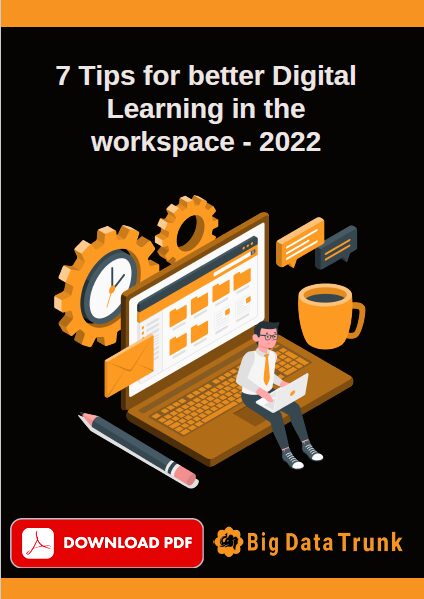Organizations seek to incorporate digital learning technologies to improve employee effectiveness. Digital learning is the use of technology to deliver education and training in various settings and across a range of devices. Digital learning is also called e-learning or computer-based learning (CBL). Digital learning has been around since the early 1960s, but it wasn’t until the mid-1980s that it started to gain traction as a disruptive technology.
This innovative form of education is now used in a wide range of industries and academic fields. 90% of companies use some digital learning system in their employee training for a better working environment.
Employees that are career-driven are people who desire to grow in their professions and will look for training options to assist them in achieving their objectives. These individuals frequently seek out training programs to help them expand their expertise and maybe advance them into a leadership position. Taking this into consideration, let’s shed some light on a few tips that’ll help organizations implement better digital learning in their workspace.
How To Implement A Successful Digital Learning Strategy At Your Workspace?
Digital learning is becoming increasingly important for businesses, but it’s not always easy to get started. Here are seven tips to help you develop a successful digital learning strategy in your industry.

1. Give employees flexible learning paths.
The increased emphasis on online training opens up dozens of new possibilities for accommodating employees’ various learning styles and collaborating on learning objectives. Microlearning opportunities and learning in the workflow will be more significant in corporate training and development.
Employees who have self-directed learning opportunities and on-demand digital courses — where they may access corporate training and online resources whenever convenient for them — have a distinct edge over those who follow a disciplined approach. According to LinkedIn’s 2018 research on workplace learning, up to 90% of companies provide digital education to their employees, according to polls.

2. Provide opportunities to learn soft skills
Since disruption has become the norm, soft skills such as change management and organizational skill development have become critical to developing successful businesses. Employers may now use digital technologies to educate such behavioral abilities in business training programs.
Employees who take advantage of digital learning opportunities are more engaged at work and have a deeper knowledge of their profession. By providing access to these resources, employers make it easier for employees to develop professionally and create a more diverse and knowledgeable workforce.
Click here to learn more about the soft skill trainings offered by Big Data Trunk.

3. Create consumer-like learning experiences
One of the most important L&D trends is to improve learning experiences, which entails providing more consumer-friendly online learning options. Employees demand quick access to online information and digital tools with user-friendly interfaces. It’s critical to get employee input on what they like and dislike, but new technologies can assist.
Employees are becoming more consumer-like, and traditional training approaches are no longer cutting it. Employees want a consumer-like experience that allows them to make better decisions, improve their skills, and feel confident in their responsibilities. A consumer-like approach will enable employees to learn at their own pace while motivated by learning content relevant to their work.

4. Find ways to boost learning engagement.
Digital learning experiences should be accompanied by monetary incentives, such as digital certificates and engagement. Users will receive valuable positive feedback from these technologies, encouraging active engagement in training opportunities and information retention.
Employee engagement is the key to achieving a productive workforce. Companies that can engage their employees will have the best chance of success, while companies that do not employ learning engagement will likely struggle to keep employees happy and motivated. Although there are many different ways to measure employee engagement, ranging from simple surveys to complex quantitative metrics, it is important to remember that the right process for engaging employees will vary depending on each company’s unique needs and its workers.

5. Explore VR, AR for corporate learning
Virtual Reality is one of the most essential of these technologies. Modern technologies such as Artificial Intelligence play a vital part in learning and development. VR and its close relative Augmented Reality are powerful digital learning technologies that have been increasingly significant since the epidemic- COVID-19 began.
There are a variety of online training delivery techniques available, and each company may adopt one or more to boost overall growth. Employee skills and expertise are onboarded, trained, and advanced via microlearning, serious games, gamification, and simulation training. With new immersive technologies, Augmented Reality (AR) and Virtual Reality (VR) are becoming increasingly popular.
Click here to learn more about the AR/VR trainings offered by Big Data Trunk.

6. Create a purpose-driven digital learning strategy
A digital learning strategy should guide all businesses and online education activities. Company and HR executives, for example, must establish essential competencies for roles, projects, and the work that workers accomplish as a foundation for developing continuous learning and self-directed initiatives that support business objectives.
7. Implementing Learning Management Systems
Many companies use Learning Management Systems to improve how they train and educate their employees. They’re also used by students who want to learn new skills in a much faster, more efficient manner. The lesson learned is that you can use an LMS to make your business better, but they aren’t always necessary for everyone.
- A learning management system (LMS) is a software application that allows collecting, storing, and distributing educational materials.
- It helps create an online learning environment for students, teachers, and administrators.
- Learning management systems (LMS) is a long-held practice in the corporate world that provides companies with a means to standardize and manage training while ensuring that employees are up-to-date with best practices.
- Learning management systems have proven to be very useful in employee training and improve overall employee engagement and retention.


